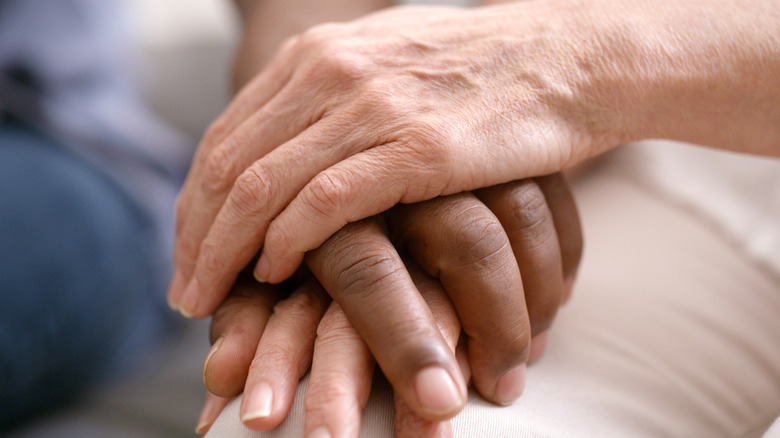The Unexpected Injury That Means The End Of Life Is Near
The signs that death is near can be multi-faceted. Some of them involve the loved one's mind, like seeing visions or hallucinations, losing interest in familiar hobbies, or seeming distant from family members and friends. Others involve lifestyle changes, like not having a big appetite for food and drink.
But one of the things that happen in the final moments before death has to do with an injury: a wound that develops in an end-of-life patient's skin. Called pressure wounds or bed sores, you've probably heard of them occurring in terminally ill people who are bound to their beds, wheelchairs, or one place for long periods of time. Pressure wounds, although common in those who are dying, can also occur in anyone who has trouble moving, like those in intensive care units. The skin is sensitive to friction when exposed to it for days, weeks, and months on end. It can become injured when this happens.
When the underlying tissue of your skin becomes damaged, infected, or dead, it can cause a great deal of discomfort to the person who's dying. Treatment usually includes making the person feel more comfortable by moving them to a different position on the bed so the wounded area gets relief and cleaning the area with saline solution. Pain medications and covering the area with bandages can also help. However, another lesser-known injury that occurs very specifically in someone nearing death is called the Kennedy terminal ulcer, or KTU.
What is a Kennedy terminal ulcer?
Named after the person who first introduced it at the National Pressure Injury Advisory Panel in Washington in 1989, Karen Lou Kennedy-Evans, KTUs are often mistaken for pressure wounds, but have some markedly different traits.
KTUs develop in the near-death patient's sacrum, the triangle-shaped space in a person's lower back also known as the tail bone. "There is a phenomenon of skin breakdown that is unavoidable at the end of life [...] I don't think we see it on every dying patient, but when we see it, because it presents as a purple or maroon area, it tends to get classified as a DTI [deep tissue injury]," shared Joyce Black, a registered nurse and National Pressure Injury Advisory Panel (NPIAP) Board Executive Committee Member (via Medline).
KTUs differ from typical pressure wounds in that they can quickly develop from a pear-shaped bruise to an irregular-shaped ulcer by the end of the day. Also, they can pop up suddenly and manifest in a few different colors (like red, yellow, purple, black, and blue). You will know tissue death has started happening when the bruise or ulcer turns darker and becomes swollen. Experts think that the reason those who are dying develop KTUs is similar to why they develop a lot of symptoms related to gradual organ failure. In this case, the organ that's failing is their skin.
How are KTUs treated?
Since someone in palliative care would be closely monitored by healthcare professionals, they are likely to notice this injury on the end-of-life patient's skin. But if you, as a loved one, happen to notice it first, it's best that you alert them about it.
As this is one of the signs that death is approaching, there's nothing much that can be done to reverse the effects of a KTU. However, hospice care workers have a few ways in which they can make the dying person feel more comfortable, like placing a soft cushion near the sacrum so the discomfort is somewhat eased. They may also do dressing changes and saline washes, apply barrier creams, and provide pain relief.
For the loved ones by the dying relative's bedside, identifying a KTU can mean facing the uncomfortable reality that death is nigh. Although this is a very natural part of what happens to your body when you die, it doesn't make the reality of it any easier to bear. You may, however, take this injury as a sign to spend time with your loved one and say your final goodbyes. It's also a good time to alert other relatives and friends who may want to visit the person who's dying. Death is, unfortunately, a life event that none of us can escape. The best we can do is find the support we can to cope and give all the love we can to the person who's passing on.



